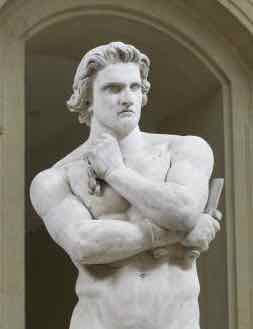Source: Oinos Educational Consulting
by Frank Marangos, D.Min., Ed.D., FCEP
“Courage is contagious. When a brave man takes a stand, the spines of others are often stiffened.”
Billy Graham
 Courage is contagious. When coupled with compassion and selfless love, courage is a powerful contagion that distinguishes the authentic philanthropist whose generosity is based on the gravity of societal privation, and not from those who seek to support the most attractive causes du’ jour. The recent death of the American actor Kirk Douglas, at the age of 103, provides a wonderful opportunity to pay tribute to such philanthropists who, like the famed thespian, director, and author, embody the influential impact of courageous altruism.
Courage is contagious. When coupled with compassion and selfless love, courage is a powerful contagion that distinguishes the authentic philanthropist whose generosity is based on the gravity of societal privation, and not from those who seek to support the most attractive causes du’ jour. The recent death of the American actor Kirk Douglas, at the age of 103, provides a wonderful opportunity to pay tribute to such philanthropists who, like the famed thespian, director, and author, embody the influential impact of courageous altruism.
In a 2012 Interview Magazine article, Douglas described how his mother influenced his life. “When I was a kid,” Douglas explained, “we would be in our little room and there would be a knock on the door almost every night with a hobo begging for food. Even though we didn’t have enough to eat, my mother always found something to give them. She said something to me that I will never forget. ‘A beggar must always give to another beggar that’s worse off than he is.’”
Throughout the years, Douglas and his wife Anne adhered to the advice of his mother and became courageous philanthropists. Whether politically-incorrect or controversial a cause might have appeared, they always focused on how they could be of immediate service to the less fortunate. In fact, among other charitable interests, Douglas and his wife championed a cause that was not chic to do so at the time. They courageously stepped forward and donated the necessary funds to establish the Anne Douglas Center for Women to help homeless women in Los Angeles. As a result, in 1981 Douglas received the Presidential Medal of Freedom for his global benevolent leadership.
Apart from his unassuming philanthropic accomplishments, Kirk Douglas is most widely acclaimed for his dramatic cinematic portrayals. Joined by Lawrence Olivier, Jean Simmons, and Tony Curtis, Douglas will always be remembered for his memorable leading role in the 1960 epic movie Spartacus about a courageous leader of a slave revolt in Classic antiquity.
Spartacus was a Thracian gladiator who inspired a revolt against the forces of Imperial Rome. Along with 70 fellow gladiators, he led a slave revolt along the Italian peninsula with an army numbering in the tens of thousands until he was killed in battle in April 71 B.C. Initially successful, the small yet valiant group of slaves were finally overwhelmed by a larger opposing army. In the now-famous scene near the end of the film, the Roman General, played by Lawrence Olivier, provides the insurgents an enticing proposal. “I will not crucify you,” promises the crafty commander, “if you turn over to me your leader Spartacus!”
In order to spare his fellow gladiators from the brutality of crucifixion, Douglas drops his sword and slowly steps forward. Before he is able to confess his identity, however, another slave stands and shouts, “I . . . am Spartacus!” In an astonishing example of courage and sacrificial love, slave after slave steps forward until all the imperiled comrades make the same claim, “I . . . am Spartacus!”
The body of Spartacus was apparently never identified. Historians point out that the gladiator/slave may have killed his horse before his final battle and may never have embellished his armor. Left as a badly disfigured body of a soldier dressed in ordinary armor, Spartacus was likely buried with his comrades in a mass grave. Nonetheless, a marble statue of the selfless leader, crafted by Denis Foyatier, stands proudly in the Louvre Museum in Paris.
Apart from being an archetype of compassion, sacrifice, and comradeship, the sculpture of Spartacus embodies the ideals of courageous philanthropy. Like a valiant gladiator who is willing to ransom himself for his fellow companions, the deeds of the courageous philanthropist are contagious in that they are based on seeing himself in the “face” of the “other.” This is exactly what Jesus implied when he made a similar exhortation. “Truly I tell you,” He said, “whatever you did for one of the least of these brothers and sisters, you did to me” (Matthew 25:40). Understood in such a transcendent fashion, we are all poor, hungry, naked, sick, and . . . homeless!
This is the kind of philanthropic leadership that the nation requires today. Society thirsts for courageous individuals like Kirk Douglas – who are not playing a role – but authentically expressing the qualities of love and service for their fellow human beings. Humanity needs philanthropists who are not driven by self-promotion, but by anyone knocking in need at their door. But who exactly is “knocking at our door?” Who are the individuals that we, like Spartacus’ brave comrades, should champion by stepping forward and courageously claiming, “WE are them!”?
The homeless are among those who are knocking. According to the General Assembly of the United Nations “homelessness, is a human rights crisis that demands an urgent global response.” The National Alliance to End Homelessness (2018) reports that there are 552,830 people experiencing homelessness on any given night in America. Thirty-three percent (33%) are families with children. Forty-eight percent (48%) are unable to work. Unfortunately, their knock at the door is not always heard or responded to in an appropriate and effective philanthropic fashion.
Coined by the Greek playwright Aeschylus (5th century BCE), the word “philanthropia,” literally means “love of humanity.” Today’s philanthropists should, therefore, be individuals who donate time, money, experience, skills and/or talent to help create a better world.
Research indicates, however, that contemporary “philanthropists” fall into three broad categories. The first general classification of donors includes those who financially support a particular cause because of the “some value they extract” from their contribution. Unlike these “transactional givers” that fall in the middle of the spectrum, the second group of donors is often referred to as the “not-at-all altruistic.” Individuals in this general grouping frequently support a cause because they want “to show off their affluence and social circle associations to business owners, friends, and potential mates.” The third and final broad category of donors are those that do so from “purely altruistic” motives. These are the courageous philanthropists who, regardless of personal risk, “value the impact of their contribution on the individual recipient.”
The good news is that, apart from making the donor happier and healthier, courageous philanthropy is contagious! Seeing others volunteer and generously give without selfish expectations, inspires others to do likewise. In fact, in several experiments, the act of volunteering was identified as a valuable predictor of gallant altruism. According to numerous studies, the example and gentle encouragement from such servant-centered individuals more than “quadruple additional donations.”
In their classic book, The Seven Faces of Philanthropy (1994), researchers Russ Prince and Karen File were one of the first to describe the characteristics of a variety of donor motivational categories. Their psychologically-based “faces” (categories) are valuable for properly identifying and, thereby, targeting a non-profit’s message that best resonates with seven distinctive donor personas: (1) Altruists, (2) Communitarians, (3) Devout, (4) Dynasts, (5) Investors, (6) Socialites, and (7) Re-payers. The more an organization can align its message to the “face” of a potential donor, the higher the possibility of soliciting a contribution.
Expanding the ground-breaking work of Prince and File, Tim Mann developed a theoretical framework that aligns psychological theory, donor attributes, and fundraising strategies. In his article, College Fund Raising Using Theoretical Perspectives to Understand Donor Motives (2010), Mann identifies four primary alignments: (1) Charitable Giving, (2) Economics, (3) Service, and (4) Social Exchange/Relationship Marketing. The Economics, Service, and Social Exchange theories all include a “transactional” element in which the donor “receives” some personal benefit in exchange for their contribution. The Charitable Giving model is the only category in which individuals selflessly support a cause “to make society a better place” irrespective of any personal benefit.
According to the Charity Dynamics Nonprofit Donor Engagement Benchmark Study (2012), and the Blackbaud Donor Perspectives Study (2012), donors contribute to nonprofit organizations when they: (1) feel most connected, and/or (2) believe that the organization’s cause is worthy of their financial support, volunteering, event participation, and issue advocacy. According to Charity Dynamics, “connected donors” indicate that they would be “willing to talk to friends and family about the organization.” The top three donor motivating factors were: (1) their personal financial situation, (2) their passion for the organization’s mission, and (3) having access to information concerning the impact of their contributions. In the end, both studies concluded that establishing emotional connections with donors is paramount.
In a 2017 study entitled, What Motivates Money Donation? External Motivators that Favor Individual Money Donation, researchers Nivea Coelho Degasperi and Emerson Wagner Mainardes identify eight external factors that motivate individuals to contribute financial resources to nonprofit organizations: (1) Trust, (2) Reward, (3) Leadership, (4) Organizational Characteristics, (5) Environmental Influences, (6) Personal Benefits, (7) Characteristics of Beneficiaries, and (8) Future Interests. The authors conclude that when the eight factors are combined, they become a useful tool to improve the management of charitable organizations with: (1) fundraising campaigns, (2) donor marketing strategies, and (3) special events. While no predominant external factor was identified, the study did conclude that the internal disposition of the donor was a powerful dynamic influence of charitable intention that should not be overlooked.
In her article, The Psychology of Giving: What Rewards Motivate Donors? (2018), Alison Carlman, Director of Marketing and Communications of the Global Giving Organization, outlines the best ways to motivate donors. Like the Charity Dynamics and Blackbaud Studies, Carlman concludes that incentives such as tote bags, bumper stickers, walls of recognition, and magazine gala photos are not effective. While personal economic status, social identity, notoriety, and tax benefits, play a role she suggests that nonprofits would be better served to design motivational giving strategies around less monogrammed, non-financial, mission-driven psychological incentives such as the philanthropic impact on the organization’s target recipient(s).
Unlike the more positive research done by Mann, Degasperi, Mainardes, and Carlman, Shoba Sreenivasan and Linda E. Weinberger identify three unhealthy donor motivations. In some cases, argue Sreenivasan and Weinberger, a donor’s giving may actually “be a paradoxical form of narcissism.” In their article, The Dark Side of Being a Giver (2019), the authors suggest that narcissistic donors often portray themselves “as martyrs, whose selflessness is prominently on display for all to admire.” Unlike the “Narcissist,” the “Compulsive Giver” is “driven by low self-esteem believing that they will only be liked if they do things for other people.”
Finally, the motivation of the “Mercantile Donor” is characterized as having “quid pro quo,” “giving-to-get,” and/or “score-keeping” expectations. Such individuals may be ever vigilant as to how much is received in proportion to how much is given, leading to a perpetual sense that the relationship with the nonprofit is an ongoing “deal negotiation.” Sreenivasan and Weinberger warn that whether martyrdom, low self-esteem, or score-keeping giving are the motivating drivers of a particular donor, “all of these forms of giving are pathological and can have a corrosive effect on relationships.”
Unlike the more self-centered, transactional, and marque-driven donors, courageous philanthropists exhibit high degrees of compassion and empathy by establishing connections and expressing care and concern for other people regardless of any personal benefit. By authentically identifying with another person’s situational feelings, courageous philanthropists exhibit compassionate behaviors such as individualized volunteering, commitment to political/regulatory reform, and strategic planned giving. Among correlations cited by an increasing number of research studies, empathetic philanthropy is related to increased happiness, decreased depression, social connections, the fostering of meaningful relationships and the promotion of healthy human adjustment.
The 2019 Netflix documentary, Inside Bill’s Brain: Decoding Bill Gates, created by filmmaker Davis Guggenheim, highlights the mind of billionaire Bill Gates as he shares stories of his childhood and business career. As co-founder of the largest private charitable foundation in the world, Gates also discusses his passion for improving the lives of people in the developing world and the audacious philanthropic goals he is currently pursuing.
Among other sage advice, Gates emphasizes the need for everyone, regardless of economic status, to “give back to their community.” “Charity,” he insists, “was instilled in me from the time I was a child . . . and should be a priority in everyone’s life.” As a result, together with his wife Melinda, Gates has decided that the vast resources they acquired through Microsoft would be best used to serve the needs of society. Like other courageous philanthropists such as Kirk and Anne Douglas, Gates looks “to give back in ways that are often overlooked,” or deemed not-so-glamorous in the eyes of society.
The Bill & Melinda Gates Foundation (BMGF) has, therefore, been a leader in committing an incredible amount of time and resources to homelessness, water purification, and toilet sanitation in developing countries. Because he is not interested in having their photograph highlighted in social charity magazines, their focus on giving back and optimizing impact sets them apart as examples of courageous philanthropists that are intent on shedding light on significant social issues that often receive little attention. “We are willing to put the reputation of our foundation on the line,” Gates insists, “and do whatever it takes to find solutions to conditions that disproportionately affect people in poor countries.”
While the vast majority of donors contribute to well-established institutions from which they or their families have received a benefit (religion, education, health care, politics), courageous philanthropists are distinguished as leaders that seek out potentially transformative opportunities that are often unknown, and/or culturally unpopular. They intentionally seek out underfunded causes where their financial resources, time, and expertise can make a difference and have the greatest impact on humanity.
Courageous philanthropy has much in common with the Roman uprising led by an ancient gladiator intent on freeing his fellow slaves from a life of pain, servitude, and death. One can be certain that Spartacus was not happy if but one individual remained disenfranchised, homeless, or enslaved. In the end, while not achieving his vision of a “slave-less society,” his life, like Douglas, Gates and other courageous philanthropic leaders, continues to inspire selfless acts of benevolence throughout the historical landscape.
Who is “knocking at our door?” Whenever this question is posed, we, like Spartacus’ courageous comrades, should step forward and courageously claim, “WE are them!”



